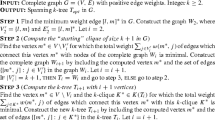Abstract
In this paper we consider a telecommunications network design problem allowing for multiple technologies. The problem arises in wide-area network and metro-area network design for which a combination of technologies may be necessary due to high traffic volumes, long-distance transmission, and design restrictions. The network design problem builds the best network to channel traffic between a set of origins and destinations, which requires selecting links, equipping them with fiber, deciding on the type of technology, and locating switches. The goal is to minimize the total cost of the network, which accounts for the flow cost, the fiber and technology costs, and the switch-location cost. We model the problem using a multicommodity network design formulation with side constraints. We apply Benders decomposition to the problem and develop a two-phase solution method that uses a number of improvements over the basic Benders algorithm. We present promising results on randomly generated test problems.
Similar content being viewed by others
References
Ahuja, R. K., Magnanti, T. L., & Orlin, J. B. (1993). Network flows: theory, algorithms, and applications. Englewood Cliffs: Prentice Hall.
Alevras, D., Grötschel, M., & Wessäly, R. (1998). Cost-efficient network synthesis from leased lines. Annals of Operations Research, 76, 1–20.
Avella, P., Mattia, S. & Sassano, A. (2004). Metric inequalities and the network loading problem. In D. Bienstock & G. Nemhauser (Eds.), Proceedings of the 10th international IPCO conference, New York, June 7–11, 2004 (pp. 16-32).
Barnhart, C., Hane, C. A., Johnson, E. L., & Sigismondi, G. (1995). A column generation and partitioning approach for multi-commodity flow problems. Telecommunication Systems, 3, 239–258.
Benders, J. F. (1962). Partitioning procedures for solving mixed integer variables programming problems. Numerische Mathematic, 4, 238–252.
Bienstock, D., & Muratore, G. (2000). Strong inequalities for capacitated survivable network design problems. Mathematical Programming, 89(1), 127–147.
Bienstock, D., Chopra, S., Günlük, O., & Tsai, C.-Y. (1998). Minimum cost capacity installation for multicommodity network flows. Mathematical Programming, 81, 177–199.
Brunetta, L., Conforti, M., & Fischetti, M. (2000). A polyhedral approach to an integer multicommodity flow problem. Discrete Applied Mathematics, 101, 13–36.
Costa, A. M. (2005). A survey on Benders decomposition applied to fixed-charge network design problems. Computers & Operations Research, 32, 1429–1450.
Crainic, T. G., Frangionni, A., & Gendron, B. (2001). Bundle-based relaxation methods for multicommodity capacitated fixed-charge Network design problems. Discrete Applied Mathematics, 112, 73–99.
Dahl, G., & Stoer, M. (1998). A cutting plane algorithm for multicommodity survivable network design problems. INFORMS Journal on Computing, 10(1), 1–11.
Geoffrion, A. M., & Graves, G. W. (1974). Multicommodity distribution system design by Benders decomposition. Management Science, 20, 822–844.
Holmberg, K. (1994). On using approximations of the Benders master problem. European Journal of Operational Research, 77, 111–125.
Holmberg, K., & Yuan, D. (2000). A Lagrangian heuristic based branch-and-bound approach for the capacitated network design problem. Operations Research, 48(3), 461–481.
Holmberg, K., & Yuan, D. (2003). A multicommodity network flow problem with side constraints on paths solved by column generation. INFORMS Journal on Computing, 15(1), 42–57.
Martin, R. K. (1998). Large scale linear and integer optimization: a unified approach. Boston: Kluwer Academic.
Mateus, G. R., & Franqueira, R. V. L. (2000). Model and heuristic for a generalized access network design problem. Telecommunication Systems, 15, 257–271.
McDaniel, D., & Devine, M. (1977). A modified Benders’ partitioning algorithm for mixed integer programming. Management Science, 24, 312–379.
Randazzo, C. D., Luna, H. P. L., & Mahey, P. (2001). Benders decomposition for local access network design with two technologies. Discrete Mathematics and Theoretical Computer Science, 4, 235–246.
Author information
Authors and Affiliations
Corresponding author
Rights and permissions
About this article
Cite this article
Gzara, F., Erkut, E. Telecommunications network design with multiple technologies. Telecommun Syst 46, 149–161 (2011). https://doi.org/10.1007/s11235-010-9278-2
Published:
Issue Date:
DOI: https://doi.org/10.1007/s11235-010-9278-2




